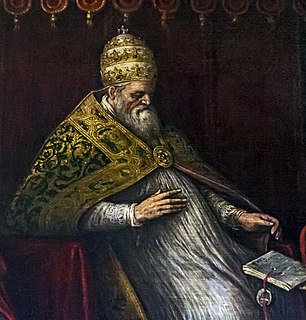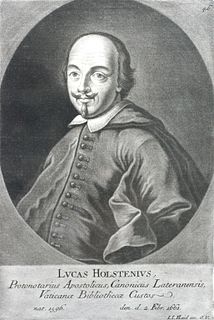Related Research Articles

The Liber Pontificalis is a book of biographies of popes from Saint Peter until the 15th century. The original publication of the Liber Pontificalis stopped with Pope Adrian II (867–872) or Pope Stephen V (885–891), but it was later supplemented in a different style until Pope Eugene IV (1431–1447) and then Pope Pius II (1458–1464). Although quoted virtually uncritically from the 8th to 18th centuries, the Liber Pontificalis has undergone intense modern scholarly scrutiny. The work of the French priest Louis Duchesne, and of others has highlighted some of the underlying redactional motivations of different sections, though such interests are so disparate and varied as to render improbable one popularizer's claim that it is an "unofficial instrument of pontifical propaganda."

Pope Alexander IV was Pope from 12 December 1254 to his death in 1261.

Pope Honorius III, born as Cencio Savelli, was the 177th Pope of the Catholic Church and ruler of the Papal States from 18 July 1216 to his death in 1227.

Pope Benedict II was Bishop of Rome from 26 June 684 to his death in 685. Pope Benedict II's feast day is May 7.

Pope Zosimus reigned from 18 March 417 to his death in 418. He was born in Mesoraca, Calabria.

Pope Innocent IV, born Sinibaldo Fieschi, was the head of the Catholic Church from 25 June 1243 to his death in 1254.

Pope Gregory VII, born Hildebrand of Sovana, was pope from 22 April 1073 to his death in 1085.

Pope Paschal I was pope from 25 January 817 to his death in 824.

Pope Simplicius was pope from 468 to his death in 483. He was born in Tivoli, Italy, the son of a citizen named Castinus. Most of what is known of him personally is derived from the Liber Pontificalis.

A papal coronation was the ceremony of the placing of the papal tiara on a newly elected pope. The first recorded papal coronation was that of Nicholas I in 858. The last was the 1963 coronation of Paul VI, who soon afterwards abandoned the practice of wearing the tiara. None of his successors have used the tiara, and their papal inauguration celebrations have included no coronation ceremony.

The Solemnity of the Immaculate Conception celebrates the solemn celebration of belief in the Immaculate Conception of the Virgin Mary. It is universally celebrated on December 8, nine months before the feast of the Nativity of Mary, which is celebrated on September 8. The Immaculate Conception is one of the most important Marian feasts in the liturgical calendar of the Roman Catholic Church, and is celebrated worldwide.
Antipope John VIII or Antipope John was an antipope of the Roman Catholic Church, in the year 844. On the death of Pope Gregory IV, the populace of Rome declared John, a deacon with no known links to the aristocracy as his successor. They seized the Lateran Palace and enthroned him there. However, the lay aristocracy elected as pope the elderly, nobly born archpriest Sergius, ejected John from the Lateran, and swiftly crushed the opposition. Pope Sergius II's consecration was rushed through immediately, without waiting for imperial ratification from the Frankish court. Although some of his supporters wanted John put to death for what they considered his presumption, Sergius intervened to save his life and John was confined to a monastery. Nothing further is known about him.

Lucas Holstenius, born Lukas Holste, was a German Catholic humanist, geographer and historian.
Liber Diurnus Romanorum Pontificum is the name given to a miscellaneous collection of ecclesiastical formulae used in the Papal chancery until about the 11th century. It fell into disuse through the changed circumstances of the times and was soon forgotten and lost.
Ecclesiastical letters are publications or announcements of the organs of Roman Catholic ecclesiastical authority, e.g. the synods, but more particularly of pope and bishops, addressed to the faithful in the form of letters.
The Liber Diurnus Romanorum Pontificum includes a formula of profession of faith that a newly elected Pope sent to the representative at Ravenna of the Emperor of Constantinople soon after the Third Council of Constantinople (680-681), which is referred to in the text as held "recently".

The erudite Augustinian Onofrio Panvinio or Onuphrius Panvinius was an Italian historian and antiquary, who was librarian to Cardinal Alessandro Farnese.
Summorum Pontificum is an apostolic letter of Pope Benedict XVI, issued in July 2007, which specifies the circumstances in which priests of the Latin Church may celebrate Mass according to what he calls the "Missal promulgated by Blessed John XXIII in 1962", and administer most of the sacraments in the form used before the liturgical reforms that followed the Second Vatican Council.

Niccolò Brancaccio was born in the Kingdom of Naples, perhaps in Naples itself. He was Archbishop of Bari and then Archbishop of Cosenza, while serving in the Roman Curia in Avignon. He became a cardinal of the Avignon Obedience in 1378, and was Cardinal Priest of Santa Maria in Trastevere and then Cardinal Bishop of Albano. He participated in the Council of Pisa in 1409, and was one of the electors of Pope Alexander V and of Pope John XXIII.
References
- ↑ "Profession of faith", not "oath", is the expression used by the authors quoted by Garnier in his comment reproduced in columns 39-40 of Patrologia Latina, 105
- ↑ Vatican Archives
- ↑ Catholic Encyclopedia: Liber Diurnus Romanorum Pontificum.
- 1 2 Philip Schaff (1877). "Creeds of Christendom, with a History and Critical notes. Volume I. The History of Creeds" . Retrieved 2007-02-26.[ permanent dead link ])
- ↑ Notes by Garnier, reproduced in columns 41-42 of Patrologia Latina, 105
- ↑ Dozens of websites that reproduce this text can be found by searching for "papal coronation oath" on Google. It is quoted also on pages 161-162 of the book, The Great Facade: Vatican II and the Regime of Novelty in the Roman Catholic Church, by Christopher A. Ferrara and Thomas A. Woods, Jr. (Remnant Press, Wyoming, Minnesota, USA, 2002, ISBN 1-890740-10-1).
- ↑ "Archived copy". Archived from the original on 2005-10-13. Retrieved 2005-10-05.CS1 maint: archived copy as title (link)
- ↑ Liber Diurnus Romanorum Pontificum in Catholic Encyclopedia
- ↑ Percival, Henry R. (1900). Philip Schaff (ed.). "The Seven Ecumenical Councils of the Undivided Church, Chapter: Excursus on the Condemnation of Pope Honorius". A Select Library of the Nicene and Post-Nicene Fathers of the Christian Church: Second Series. Christian Literature Company. 3: 351.
- ↑ Gladstone, William Ewart; Philip Schaff (1875). The Vatican Decrees in Their Bearing on Civil Allegiance: A Political Expostulation. Harper & brothers. pp. 98.
- ↑ For purposes of comparison, the text in Migne's Patrologia Latina, vol. 105, cols. 40-44 is:
In nomine Domini Dei Salvatoris nostri Jesu Christi, etc. Indictione Ill. mense Ill. Ego Ill. misericordia Dei presbyter et Electus, futurusque per Dei gratiam humilis Apostolicae sedis Antistes, tibi profiteor, beate Petre Apostolorum Princeps, (cui claves regni caelorum ad ligandum atque solvendum in caelo et in terra, creator atque redemptor omnium Dominus Jesus Christus tradidit, inquiens: Quaecumque ligaveris super terram, erunt ligata et in coelo; et quaecumque solveris super terram, erunt soluta et in coelis) sanctaeque tuae Ecclesiae, quam hodie tuo praesidio regendam suscepi.
Hanc verae fidei rectitudinem (quam Christo autore tradente, per successores tuos atque discipulos, usque ad exiguitatem meam perlatam, in tua sancta Ecclesia reperi, totis conatibus meis, usque ad animam et sanguinem custodire, temporumque difficultates, cum tuo adjutorio, toleranter sufferre.)
Tam de sanctae et individuae Trinitatis mysterio, quae unus est Deus; quam de dispensatione, quae secundum carnem facta est, Unigeniti filii Dei Domini nostri Jesu Christi, et de caeteris Ecclesiae dogmatibus, sicut in universalibus Conciliis, et Constitutis Apostolicorum Pontificum probatissimorum, atque Doctorum Ecclesiae scriptis sunt commendata; item quaecumque ad rectitudinem vestrae nostraeque orthodoxae fidei, a te traditae, respiciunt, conservare.
Sancta quoque universalia Concilia, Nicaenum, Constantipolitanum, Ephesinum primum, Chalcedonense, et secundum Constantinopolitanum, quo Justiniani piae memoriae Principis temporibus celebratum est, usque ad unum apicem, immutilata servare.
Et una cum eis pari honore et veneratione sanctum sextum Concilium quo nuper Constantino piae memoriae Principe, Agathone Apostolico praedecessore meo convenit, medullitus et plenius conservare, quaeque vero praedicaverunt, praedicare; quaeque condemnaverunt, ore et corde condemnare.
Diligentius autem et vivacius omnia decreta praedecessorum Apostolicorum nostrorum Pontificum, quaeque synodaliter statuerunt, et probata sunt, confirmare, et indiminute servare, et sicut ab eis statuta sunt, in sui vigoris stabilitate custodire; quaeque vel quosque simili autoritatis sententia condemnaverunt, vel abdicaverunt, simili autoritatis sententia condemnare.
Disciplinam et ritum Ecclesiae, sicut inveni, et a sanctis praecessoribus meis traditum reperi, inlibatum custodire.
Et indiminutas res Ecclesiae conservare, et ut indiminutae custodiantur, operam dare.
Nihil de traditione, quod a probatissimis praedecessoribus meis servatum reperi, diminuere vel mutare, aut aliquam novitatem admittere; sed ferventer, ut vere eorum discipulus et sequipeda, totis viribus meis conatibusque tradita conservare ac venerari.
Si qua vero emerserint contra disciplinam canonicam, emendare; sacrosque Canones et Constituta Pontificum nostrorum, ut divina et coelestia mandata, custodire, utpote tibi redditurum me sciens de omnibus, quae profiteor, districtam in divino judicio rationem, cujus locum divina dignatione perago, et vicem intercessionibus tuis adjutus impleo.
Si praeter haec aliquid agere praesumpsero, vel ut praesumatur, permisero, eris, mihi, in illa terribili die divini judicii, depropitius.
Haec conanti et diligenter servare curanti, in hac vita corruptibili constituto, adjutorium quoque ut praebeas obsecro, ut irreprehensibilis appaream ante conspectum judicis omnium Domini nostri Jesu Christi, dum terribiliter de commissis advenerit judicare, ut faciat me dextrae partis compotem, et inter fideles discipulos ac successores tuos esse consortem.
Quam professionem meam, ut supra continetur, per Ill. Notarium et Scriniarium me mandante conscriptam, propria manu subscripsi, et tibi, beate Petre Apostole et Apostolorum omnium Princeps, pura mente et conscientia devota, corporali jurejurando sinceriter obtuli.
Subscriptio. Ego qui supra Ill. indignus presbyter Dei gratia electus hujus Apostolicae sedis Romanae Ecclesiae Episcopus, hanc professionem meam, sicut supra continet, faciens jusjurandum corporaliter tibi, beate Petre Apostolorum Princeps, pura mente et conscientia obtuli. - ↑ "Thou", "Thee" and "Thy" are given upper-case initials, and there is reference to "Thy Divine Tribunal". It is therefore addressed to one of the Persons of the Trinity. "Through the grace of God, Whose Vicarship I possess with Thy support" shows that the person addressed ("Thy") is not God the Father, who is mentioned in the third grammatical person.
- ↑ The "Papal Oath" speaks of "Christ and His Successors", and presents the Pope as claiming to replace Christ: "I am conscious of Thee, whose place I take".
- ↑ "through the grace of God, Whose Vicarship I possess"
- ↑ "I will keep whatever has been revealed through Christ and His Successors."
- ↑ "as her (i.e. of "the received Tradition") truly faithful student and successor"
- ↑ Kurtz, Johann Heinrich (1889). Church History. John Macpherson. New York: Funk & Wagnalls. pp. 489.
- ↑ See "COUNCIL OF BASEL (1431-1445)". Eternal Word Television Network . Retrieved 2007-02-27.

